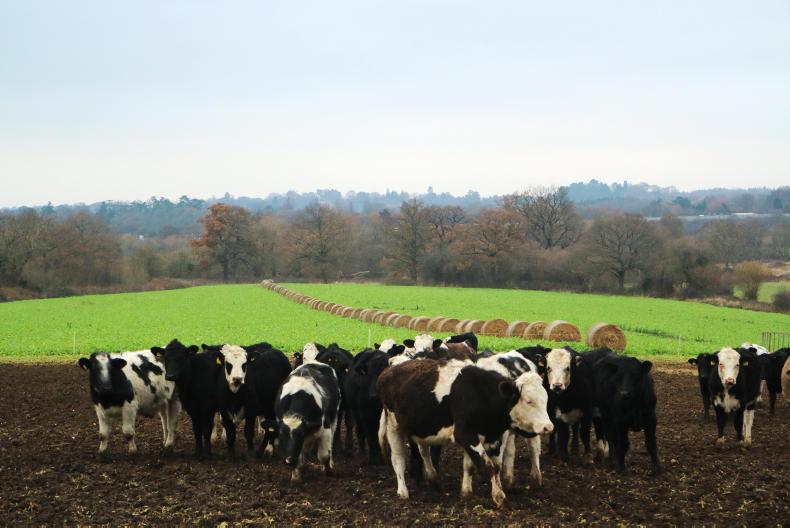Even at this early stage, Rob’s system has developed to the extent that he has control over the sires used to produce his animals.
“I work with about 40 dairy farmers in the area. I’m looking for a Holstein-Friesian cow to give size. Initially, my calf team sourced any Hereford-sired calves to give me throughput, but at the same time I started to provide the farms with Hereford AI straws or even bulls to work as sweepers. I buy the calf back indirectly through two local calf dealers, selecting only the top 25% of calves for my own use.
Rob pays £180 to £200 for his two-week-old Hereford-cross calves, which includes £10/head for the dealer. Calves then go to one of two rearing farm.
.@CiaranLen delves deeper into the components of @robdvet’s integrated beef production system in southern England https://t.co/IwH20xgfxC pic.twitter.com/LoOHJZSUzt
— FJ Beef (@FJBeef) January 15, 2017
Rearing
“Calves arrive at the rearers at 45kg to 50kg and the guys are paid upon delivering a reared animal that hits the targets. My animals won’t be the only calves on their farms – they have their own and rear for others too. All the calves on the unit are reared following the same protocols with milk powder, cake feeding and vaccination regimes all consistent to ensure a healthy strong calf.
When all is costed, the rearers make a margin of £35/head before labour...
Rob’s system needs a reared calf coming in at 120kg after 11 to 12 weeks. When all is costed, the rearers make a margin of £35/head before labour, as well as a weight-for-age bonus of £1/kg above Rob’s target of 120kg at 84 days old.
“These guys are fantastic. In the past three years they have reared over 5,000 calves between them for less than 50 deaths. We work together on everything from building modifications to feeding regimes to vaccinations.”
Growing
Near the end of the rearing phase, Rob’s calves will have transitioned on to exclusively forage/concentrate diets. Once ready, groups of 60 to 80 calves move to a growing farm. This is simply a grass-based suckler farm, with a dedicated shed set aside that Rob can fill and grazing ground for the integrated beef.
“We sort of control growth rates on these farms. They’ll arrive, go indoors for a while on their forage/concentrate mix and then transition to grass.“
The growing farmer is paid based on weight gain at £1.10/kg...
“We use outdoor concentrate feeders and feed based on our future obligations. If there looks to be a hole in our supply down the line, we can feed on a number. If not, we try to keep them ticking over at grass and put down some frame before moving to finish. No calf is on grass alone before reaching 200kg – the rumen capacity just isn’t there to hit the growth rates I need below that weight.”
Cattle are housed at 350 to 400 days to be fed a grass-based total mixed ration (TMR) aiming at 1.5kg/day of gain to be ready to leave the growing farm at 500kg by 13 to 15 months old. The growing farmer is paid based on weight gain at £1.10/kg with Rob taking care of all veterinary costs plus nutritional planning.
Finishing
Finally, Rob’s cattle move to a finishing unit, run by Michael and Ian Sturmer, targeting a 65-day intensive feed period. This unit has the capacity for 850 head, with Rob typically having 60 to 80 on site at any one time.
“We get phenomenal performance during finishing – averaging 1.9kg to 2.2kg per day depending on the batch. Integration means when the animal arrives here, its rumen is prepared for the TMR diet and our attention to detail over the previous 13 to 15 months ensures the cattle are well backgrounded. I’m charged by the day here when the cattle are on feed. It’s expensive, but required to get the finish.”
The diet is 50% forage-based (maize and grass silage) and includes wheat distillers, soya hulls, rolled wheat and a protein blend.
Rob’s return
“Between my processor timing and breed bonuses, I’m running about 50p ahead of conventional beef price at the moment. At this rate, I make 5% to 10% per head myself, but view this as return on money invested, as my role in the whole thing is very much a people manager. But obviously I do vet and consultancy work with all involved and help with sourcing of feeds and any drugs required.
“My Nuffield findings showed that scale in beef production can be produced by integration of individual farmers to work to one common goal. This needs investment and time from outside, and that’s where I fit in. Growing this system is feasible and using dairy beef means I can programme the next steps easily enough.”






 This is a subscriber-only article
This is a subscriber-only article















SHARING OPTIONS: